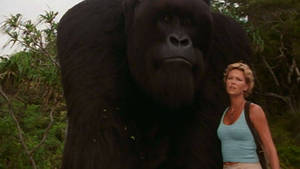Film provides a platform for racial stereotypes to indoctrinate its viewers and relay social prejudices. Lester and Ross argue that ‘the predominant juxtaposition of images of blacks and social problems- welfare, crime, poverty, drugs, violence…implicitly helps to activate long-existing stereotypes of blacks as sambo and savage’ [1]. The black African poachers in Mighty Joe Young illustrate these brutal images of savagery and violence that Lester and Ross observe. The black Africans are presented as poachers and stand as a threat to the natural landscape and, more importantly, Joe and Jill Young’s intimate and emotional animal-human bond.
As Bill is trying to get close enough to Joe to collect a blood sample, a chaotic car chase ensues in pursuit of the magnificent beast. The black poachers are swayed by Bill through the promises of ‘Triple pay!’ and they aid him in his assignment. One of the poachers defies Bill’s orders and a fast paced tracking shot shows the poacher climb into the front of the car and manoeuvre the cruel restraining device towards Joe. The musical score constructs a dramatic tension through a building of chilling violin tones and deep drum beats that are interspersed with shouting, thus creating a tone of danger and suspension. The mise-en-scene captures an emphatic image of the black poacher using violence to hunt Joe and is a stark contrast to how Bill, the white American, interacts with the animal. Although brief, this is a subtle exemplification of the white and black disparities that the Disney Films (sub)consciously portray.
Furthermore, Entman and Rojecki regard this as ‘the public face of race’, they argue that ‘it is cloaked in chameleon-like form, an ever changing camouflage that obscures its force’. [2] These scenes are a powerful contrast to the scenes of Jill and Joe’s interactions. Handheld perspective shots that alternate from Jill to Joe exemplify their spiritual and emotion connection. This is followed by a long shot showing Jill and Joe stood opposite one another and her white body unambiguously contrasts her Gorilla counter-part’s magnificent, dark stature. The African Rainforest and its tranquil waterfall serves as a majestic back-drop to their innate bond and depicts an image of organic unity. Furthermore, they communicate in whistles and correspond a mutual language that portrays Jill as the attentive caregiver and Joe as the protector. Jill symbolises the all-American white heroine, the protector of the natural world and a moral embodiment of the idealized national soul. The polarity in the relationships of Joe and the poachers and Joe and Jill follows a tradition of stereotyping that persists through media, thus influencing the minds of young Walt Disney audiences on a global scale.
[1] Paul Martin Lester and Susan Dente, The Black Image in the White Mind: Media and Race in America, 2nd edn (Westport Connecticut: Praeger Publishers, 2003), p. 92.
[2] Robert N Entman and Andrew Rojecki, The Black Image in the White Mind: Media and Race in America (Chicago and London: The University of Chicago Press, 2000), p. 1.
